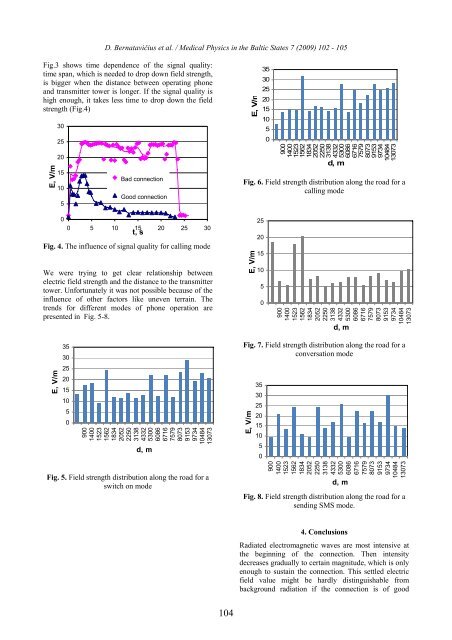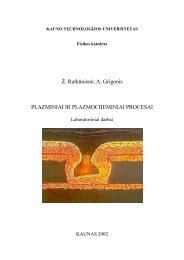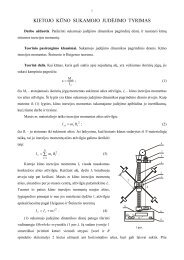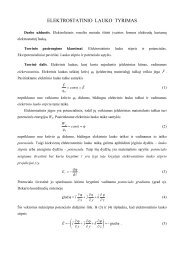PROCEEDINGS OF THE 7 INTERNATIONAL ... - Fizika
PROCEEDINGS OF THE 7 INTERNATIONAL ... - Fizika
PROCEEDINGS OF THE 7 INTERNATIONAL ... - Fizika
You also want an ePaper? Increase the reach of your titles
YUMPU automatically turns print PDFs into web optimized ePapers that Google loves.
D. Bernatavičius et al. / Medical Physics in the Baltic States 7 (2009) 102 - 105<br />
Fig.3 shows time dependence of the signal quality:<br />
time span, which is needed to drop down field strength,<br />
is bigger when the distance between operating phone<br />
and transmitter tower is longer. If the signal quality is<br />
high enough, it takes less time to drop down the field<br />
strength (Fig.4)<br />
E, V/m<br />
30<br />
25<br />
20<br />
15<br />
10<br />
5<br />
0<br />
Bad connection<br />
Good connection<br />
0 5 10 15 20 25 30<br />
t, s<br />
Fig. 4. The influence of signal quality for calling mode<br />
We were trying to get clear relationship between<br />
electric field strength and the distance to the transmitter<br />
tower. Unfortunately it was not possible because of the<br />
influence of other factors like uneven terrain. The<br />
trends for different modes of phone operation are<br />
presented in Fig. 5-8.<br />
E, V/m<br />
35<br />
30<br />
25<br />
20<br />
15<br />
10<br />
5<br />
0<br />
900<br />
1400<br />
1523<br />
1562<br />
1834<br />
2052<br />
2250<br />
3138<br />
4332<br />
5300<br />
6086<br />
6716<br />
7579<br />
8073<br />
9153<br />
9734<br />
10484<br />
13073<br />
d, m<br />
Fig. 5. Field strength distribution along the road for a<br />
switch on mode<br />
104<br />
E, V/m<br />
35<br />
30<br />
25<br />
20<br />
15<br />
10<br />
5<br />
0<br />
900<br />
1400<br />
1523<br />
1562<br />
1834<br />
2052<br />
2250<br />
3138<br />
4332<br />
5300<br />
6086<br />
6716<br />
7579<br />
8073<br />
9153<br />
9734<br />
10484<br />
13073<br />
d, m<br />
Fig. 6. Field strength distribution along the road for a<br />
calling mode<br />
E, V/m<br />
25<br />
20<br />
15<br />
10<br />
5<br />
0<br />
900<br />
1400<br />
1523<br />
1562<br />
1834<br />
2052<br />
2250<br />
3138<br />
4332<br />
5300<br />
6086<br />
6716<br />
7579<br />
8073<br />
9153<br />
9734<br />
10484<br />
13073<br />
d, m<br />
Fig. 7. Field strength distribution along the road for a<br />
conversation mode<br />
E, V/m<br />
35<br />
30<br />
25<br />
20<br />
15<br />
10<br />
5<br />
0<br />
900<br />
1400<br />
1523<br />
1562<br />
1834<br />
2052<br />
2250<br />
3138<br />
4332<br />
5300<br />
6086<br />
6716<br />
7579<br />
8073<br />
9153<br />
9734<br />
10484<br />
13073<br />
d, m<br />
Fig. 8. Field strength distribution along the road for a<br />
sending SMS mode.<br />
4. Conclusions<br />
Radiated electromagnetic waves are most intensive at<br />
the beginning of the connection. Then intensity<br />
decreases gradually to certain magnitude, which is only<br />
enough to sustain the connection. This settled electric<br />
field value might be hardly distinguishable from<br />
background radiation if the connection is of good








